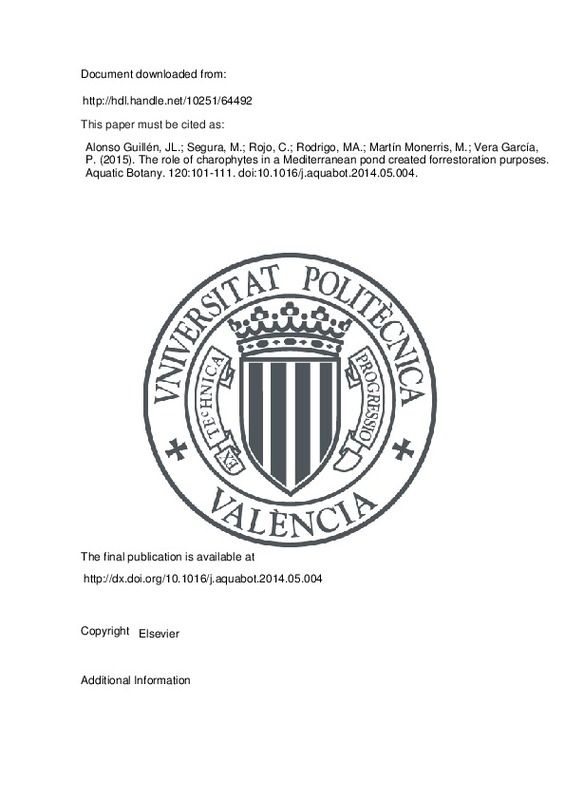JavaScript is disabled for your browser. Some features of this site may not work without it.
Buscar en RiuNet
Listar
Mi cuenta
Estadísticas
Ayuda RiuNet
Admin. UPV
The role of charophytes in a Mediterranean pond created forrestoration purposes
Mostrar el registro sencillo del ítem
Ficheros en el ítem
| dc.contributor.author | Rodrigo, María A.
|
es_ES |
| dc.contributor.author | Rojo, Carmen
|
es_ES |
| dc.contributor.author | Segura, Matilde
|
es_ES |
| dc.contributor.author | Alonso Guillén, José L.
|
es_ES |
| dc.contributor.author | Martín Monerris, Miguel
|
es_ES |
| dc.contributor.author | Vera García, Pablo
|
es_ES |
| dc.date.accessioned | 2016-05-20T17:13:23Z | |
| dc.date.available | 2016-05-20T17:13:23Z | |
| dc.date.issued | 2015-01 | |
| dc.identifier.issn | 0304-3770 | |
| dc.identifier.uri | http://hdl.handle.net/10251/64492 | |
| dc.description.abstract | A small, shallow basin was created and flooded with groundwater in a Reserve Area in Albufera de València Natural Park (AVNP) under the scope of a restoration program intended to mimic typical environments such as freshwater springs, abundant in the past but currently suffering from deterioration (desiccation, pollution, etc.), with the ultimate goal of increasing local biodiversity of submerged macrophytes, particularly charophytes. In this study we have monitored, from April 2009 (a few months after its first flooding) to September 2012, the dynamics of charophyte growth and related physical, chemical and biotic variables to highlight the factors determining charophyte success. Just after flooding, five charophyte species grew spontaneously when oospores germinated in the sediments. Chara hispida populations largely dominated the community and developed dense meadows that covered virtually the entire pond floor. Charophytes exerted a negative influence on phytoplankton densities, increasing water transparency. C. hispida stands precipitated substantial CaCO3 in the form of incrustations on the plants, accompanied by coprecipitation of inorganic phosphorus, maintaining low concentrations of soluble P in the water. Reduced groundwater inflow, increased salinity, nutrient concentration, turbidity and augmented feeding pressure by waterfowl, separately or by synergistic effects, considerably reduced charophyte development during the final year of the study; however, charophytes still represent one of the most extensive and dense stands of submerged vegetation within AVNP, verifying the achievement of the goal of the restoration plan. The knowledge obtained has allowed us to recommend several measures to counteract the decrease of charophytes, which can also be applied in other regions affected by the same stressors. © 2014 Elsevier B.V. All rights reserved. | es_ES |
| dc.description.sponsorship | The authors express thanks for the funding of this study by TRAGSA and Confederacion Hidrografica del Jucar (J. Ferrer, T. Estrela, M. Regidor) and by the Spanish Ministry of Economy and Competitiveness (research project CGL2009-10292, including plan E). We also thank Fidel Rubio, Jara Garcia-Chicote, Fran Cortes, Sara Calero and William Colom for their help during field and laboratory work. We also thank Matthieu Lassalle, Lucia Moreno and Lurdes Ribera (Tancat de la Pipa staff), particularly for providing data on inflows and water depth. We are grateful for the collaboration of the other members of the research group from Instituto de Ingenieria del Agua y Medio Ambiente (Polytechnic University of Valencia) and of Mario Gimenez from SEO/Birdlife. The waterfowl censuses were part of the SEO/BirdLife's Bird Monitoring Program in AVNP, supported by the Alas sobre Agua Project and with the valuable help of many volunteers. Joan M. Benavent facilitated the aerial photography of the pond. Dominique Auderset-Joye made constructive comments on the manuscript. American Journal Experts carefully reviewed the English language of the manuscript. | en_EN |
| dc.language | Inglés | es_ES |
| dc.publisher | Elsevier | es_ES |
| dc.relation.ispartof | Aquatic Botany | es_ES |
| dc.rights | Reserva de todos los derechos | es_ES |
| dc.subject | Chara hispida meadow | es_ES |
| dc.subject | Nitella hyalina | es_ES |
| dc.subject | Sediment bank | es_ES |
| dc.subject | Charophyte recovery | es_ES |
| dc.subject.classification | INGENIERIA HIDRAULICA | es_ES |
| dc.subject.classification | TECNOLOGIA DEL MEDIO AMBIENTE | es_ES |
| dc.title | The role of charophytes in a Mediterranean pond created forrestoration purposes | es_ES |
| dc.type | Artículo | es_ES |
| dc.identifier.doi | 10.1016/j.aquabot.2014.05.004 | |
| dc.relation.projectID | info:eu-repo/grantAgreement/MICINN//CGL2009-10292/ES/El binomio fitoplancton-macrófitos sumergidos. Sus respuestas frente a cambios globales (aumento de la radación ultravioleta y Eutrofización) e implicaciones en la gestión de humedales/ | es_ES |
| dc.rights.accessRights | Abierto | es_ES |
| dc.contributor.affiliation | Universitat Politècnica de València. Departamento de Ingeniería Hidráulica y Medio Ambiente - Departament d'Enginyeria Hidràulica i Medi Ambient | es_ES |
| dc.description.bibliographicCitation | Rodrigo, MA.; Rojo, C.; Segura, M.; Alonso Guillén, JL.; Martín Monerris, M.; Vera García, P. (2015). The role of charophytes in a Mediterranean pond created forrestoration purposes. Aquatic Botany. 120:101-111. https://doi.org/10.1016/j.aquabot.2014.05.004 | es_ES |
| dc.description.accrualMethod | S | es_ES |
| dc.relation.publisherversion | http://dx.doi.org/10.1016/j.aquabot.2014.05.004 | es_ES |
| dc.description.upvformatpinicio | 101 | es_ES |
| dc.description.upvformatpfin | 111 | es_ES |
| dc.type.version | info:eu-repo/semantics/publishedVersion | es_ES |
| dc.description.volume | 120 | es_ES |
| dc.relation.senia | 284282 | es_ES |
| dc.contributor.funder | Ministerio de Ciencia e Innovación | es_ES |
| dc.contributor.funder | Sociedad Española de Ornitología | es_ES |
| dc.contributor.funder | Universitat Politècnica de València | es_ES |
| dc.contributor.funder | Empresa de Transformación Agraria, S.A.; Confederación Hidrográfica del Júcar | es_ES |







![[Cerrado]](/themes/UPV/images/candado.png)

